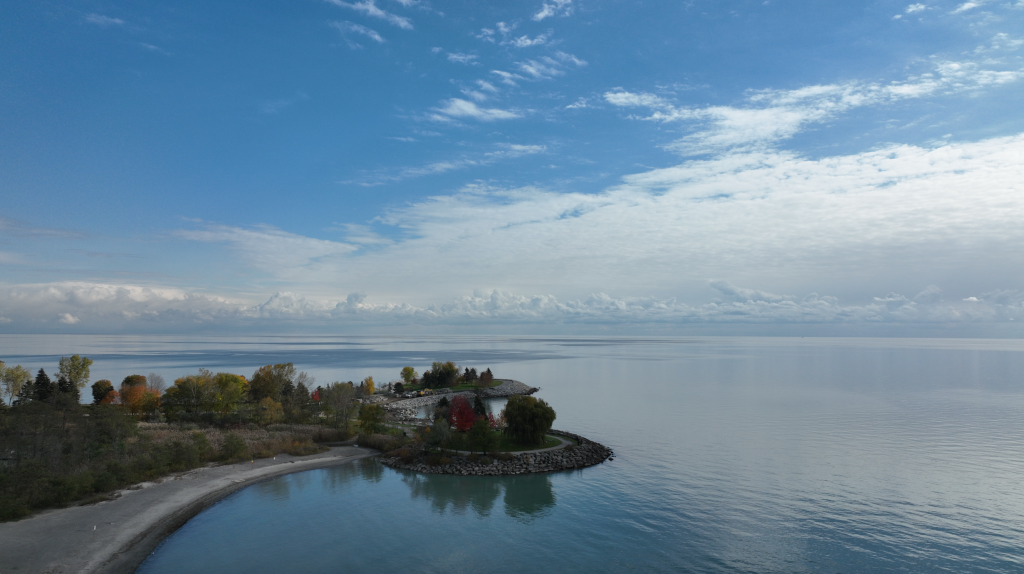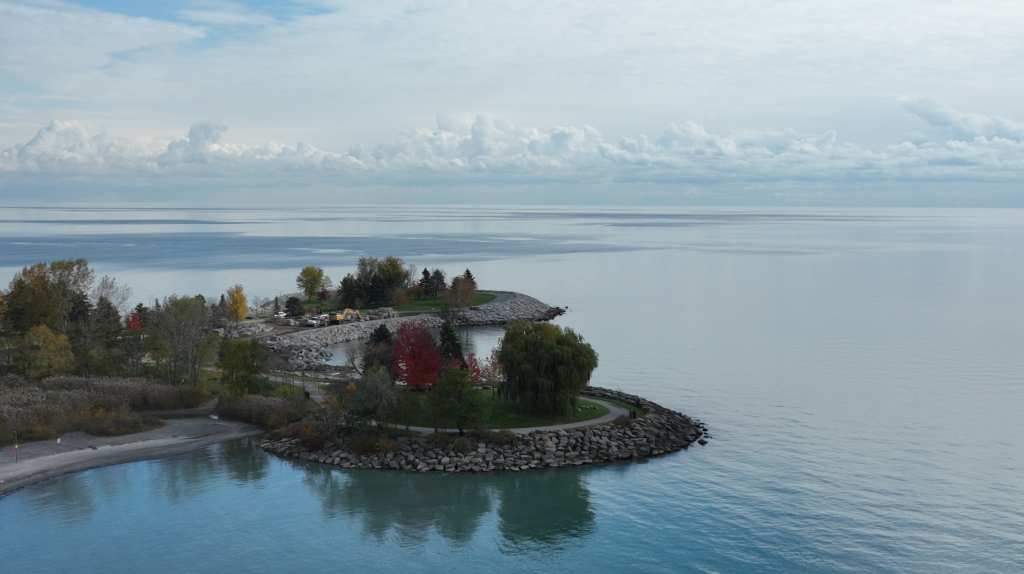
Well, after what feels like the world’s longest drumroll…the DJI Mavic 3 is here. We’ve had our hands on the standard Fly More Combo and have had some time – albeit limited – to check out this drone’s capabilities. It has a lot going for it…so let’s dive in with our Top 10 reasons to consider buying the DJI Mavic 3 drone.
What we had known as the Mavic Pro line was definitely due for a refresh. After all, it’s been more than three years since the Mavic 2 Pro line was released in August of 2018. So DJI has had a lot of time to rethink this drone – and it shows. The new Mavic 3 Standard is a significant redesign of the old Mavic Pro line, offering significant benefits over the old series. To put it bluntly, I’m impressed.
How impressed? I’m considering selling my Inspire 2 and going for the Cine model. Why? Well, let’s get into our list of the things that are looking good on the DJI Mavic 3.
DroneDJ’s DJI Mavic 3 Top 10 list
1. This is a total re-design
As noted above, this isn’t like DJI’s previous upgrades of product lines. This is a drastically different drone than the previous Mavic Pro lineup, and was designed from the ground up. We’ll explore most of the key features that stand out, but this is a significant overall point. Remember how each iteration of the Phantom line was more like an evolution rather than a revolution? (Yes, some might argue the Phantom 4 Pro and Inspire 2 were pretty significant leaps – and they were.) Well, the Mavic 3 really pushes this envelope. There is a ton packed into this new drone.

2. New Hasselblad camera
Most consumers and prosumers who buy DJI drones do so for their image quality. And so DJI has put a lot of thought into the new camera module (which also includes a zoom).
The new main camera features a professional-grade 4/3 CMOS sensor with a 24mm prime lens with an 84° Field of View. And yes, it gives you multiple shooting options. You can shoot 12-bit RAW format, and much more.
The standard version will allow you to capture video in 5.1K at 50 frames per second, and 4K at 120 fps. The Cine version, of course, can shoot Apple ProRes 422 HQ – a format wanted by many professionals. It also features a 1TB SSD, plus a 10Gbps Lightspeed Data Cable for really fast downloads. No more messing around with MicroSD cards, at least not in the Cine model.

The camera (which is identical on both the Standard and Cine models) also includes a key feature that many pros absolutely demand: A variable aperture. You can manually adjust from f/2.8 through to f/11. It has a native dynamic range of 12.8 stops, meaning you’ll capture more detail across the range from deep blacks and shadows through to very bright spots. (Plus, it ships with a set of four ND filters.)

The camera also features what’s called the Hasselblad Natural Color Solution, or HNCS. That means, says DJI, the colors of the processed image are as close to the real thing as possible. We had limited time with this machine (our standard model review unit arrived Tuesday), but in our testing over five flights, we found the colour straight our of the camera looked very, very good.
3. Extended flight time
DJI’s new Mavic 3, both the Standard and Cine, features a significant improvement in flight time. And this isn’t just a minor improvement. Under ideal conditions, you can keep your Mavic 3 in the air for up to 44 minutes.
Yes, 44 minutes.
This wasn’t a simple task, according to DJI. The company re-engineered the motors for greater efficiency. It made the body of the drone lighter. It re-designed the propellors. It packed more power into the energy-dense, rear-loading batteries.

But it also – and this is quite cool and no small engineering feat – did extensive wind-tunnel testing (and, presumably, Computer Fluid Dynamics testing), to make the body, arms and even camera module more aerodynamic. DJI says that “Wind tunnel testing shows Mavic 3 produces 35% less drag than previous generations, allowing faster top speeds.”

I’ve attended international air shows where companies that manufacture passenger jets trumpet efficiency gains of like 1.5 per cent (which can make a huge difference in a fleet’s annual fuel costs). But to see a reduction of 35 per cent in drag is really something. In my own testing, this thing just does not quit. It feels like you can just keep on flying…and that’s a huge bonus.
4. The DJI Mavic 3 has insane Zoom capabilities
If you’ve been following the leaks, you’ll be aware that the DJI Mavic 3 has a 28x zoom. This a hybrid zoom, combining 7x optical with 4x digital. In practical terms? It’s amazing. Most of us have been living with a single, wide-angle lens. Now, you can zoom in to an amazing degree. How amazing? Well, check out these photos, showcasing a variety of zoom settings, all the way up to 28x.
Yes, the digital does tear things up when you push it all the way. But really, that’s pretty astonishing. I mean, you can’t even see me in the first couple of images.

Original size 
Getting closer… 
and closer.. 
and closer.. 
Until 28x
When you do reach the 28x mark, the digital zoom really starts to show. But it’s still phenomenal, and most people aren’t going to be trying to capture quality at 28x. But if you’re looking to identify a feature or further explore some cool thing you’ve spotted – or, as I did today, check out some wildlife without getting so close as to disturb it – this drone can do it.
5. Yaw rate is connected to Zoom
Have you ever used a telescope and tried to quickly find something in the sky? It’s difficult, right? Same goes for binoculars.
Well, DJI has added a feature whereby the yaw inputs are dampened when in zoom mode. The more you are zoomed in, the slower the yaw will respond. The concept here is to help you stay on your object or interest, or to explore things close by, without losing your sense of where you are. It’s a handy feature when you’re zoomed in and want to basically nudge the camera either way without losing your way and having to start from scratch (meaning zoom out, centre the subject, and zoom back in).
6. Ocusync 3+
O3+, as DJI calls it, is a new and improved version of its communication system between the controller and the drone. The new O3+ that’s onboard this system will allow you to control from up to 15 kilometres away, and DJI says it is less prone to interference. Not only is it more stable, say DJI, but there’s less lag.
You also get 1080p at 60 fps back on your phone or tablet’s display. In our experience, the picture was crystal clear on our iPhone 12 Pro Max, even when we were whipping about two metres over the water at full speed in sports mode.
7. Advanced Return to Home
The Mavic 3 has a more sophisticated RTH routine than its predecessors. Prior to the Mavic 3, recent DJI drones would simply ascend over any obstacles and continue heading home in a straight line. This drone is different. Here’s how DJI describes the improvement, which does indeed appear to be significant, in its news release:
Mavic 3 updates and improves this system by allowing the aircraft to automatically determine the shortest, safest, and energy-efficient route to land back at its home point. At the same time, the drone measures the wind speed of the current environment and calculates the power required for returning home based on the wind speed and the return path in real-time. This provides users with more time flying safely before triggering the RTH action.
8. Omnidirectional object sensing
DJI has added sensors to this drone – and also repositioned them. The two sensors above the camera are no longer facing straight forward, as in previous iterations. Instead, they’re on a 45° angle to provide additional coverage of objects off to the side.

Same goes for the two sensors on the rear; they’re also wide-angle and positioned on that 45° angle to maximize coverage.

In addition, there are two sensors on the top at the rear of the drone ^ – as well as downward-facing sensors.

Working collectively, these sensors help the Mavic 3 drone start sensing objects from up to 200 metres away and – at least in theory – provide a 360° smart bubble of protection. That’s a tremendous upgrade, and will provide far greater obstacle avoidance than in the past (unless you’re in Sports mode).
We’ve seen some footage during a briefing with DJI that was truly impressive on the obstacle avoidance and tracking fronts, and look forward to exploring that during further testing.
9. AirSense
DJI introduced this feature with the Air 2s, and followed it up with the DJI FPV drone. It’s a detection system that will alert you if a crewed aircraft is approaching – providing it’s equipped with an Automatic Dependent Surveillance-Broadcast (or ADS-B) transponder. It’s a tremendous safety feature, which actually pinged me several times today, shortly before small Cessnas appeared near where I was flying.
The Cessnas were above 400′ AGL, and I was well below, but this additional advance warning time is a feature that really should be on every drone sold. It’s on this one.
10. It’s quiet
The props and engines on this machine are surprisingly quiet. I was actually quite stunned. No, it’s not, like, whisper-quiet – but it’s significantly quieter than I anticipated it would be. I was flying a NAV Canada approved flight in an area where there were a few other folks enjoying the day. No one appeared to hear the drone once I was above about 20-30 metres.
I’ll have to bring along the decibel meter next time I’m out – but my brain is telling me this drone is quieter than my recollection of the Air 2S.
All this, without getting into the Cine version
If you’ve got the coin, the Cine Premium Combo offers the ability to support Apple ProRes 422 HQ video recording, storing it all on an internal 1TB Solid State Drive. It also has a special “Lightspeed Data Cable” so you won’t fall asleep while waiting for all that video to download to your computer. (The Standard version includes a WiFi 6 transfer option.)
If you’re looking to do commercial work, bear in mind that many production houses have a preference for Apple ProRes 422 HQ.
Wait, there’s more!
Truth is, we missed some of the features that also deserved a mention. But these 10 were the ones that truly caught our eye. DJI, in a briefing, highlighted these key takeaways. We didn’t feel it was worth mentioning features like MasterShots, since most people are familiar with these from the Air 2S (and maybe the Mini 2?).
Anyway, we think we’ve captured pretty much all of it, but you can cross-reference against this:

DroneDJ’s Take
Like everyone else, we were really looking forward to seeing this machine. It was a long time coming, so our expectation were high.
We weren’t let down. The drone handles very well and the imaging we’ve had a chance to capture so far on the Standard model looks pretty great. We like the features we’ve outlined above – and really appreciate the new flight time and greater stability promised by O3+. (And hey, 1080p at 60fps is pretty cool.) Plus, of course, we’re excited about the Hasselblad with its 4/3 CMOS sensor.
But it’s not inexpensive. So, is it worth the money?
Only you can answer that, based on your own needs, budget etc. But there’s a lot packed in here, and we anticipate the DJI FLY app will be upgraded before long to offer additional features and more granular control over the camera than we were seeing with the Beta app. A machine like this deserves it, and consumers will want it.
Want to check out the DJI Mavic 3 further?
The Mavic 3 Standard version retails for $2199 USD and includes Mavic 3 drone × 1, Intelligent Flight Battery × 1, RC-N1 Remote Controller × 1, RC-N1 Cable × 3, Battery Charger × 1, Storage Cover × 1, Propellers (pair) × 3, and other bits and pieces.
The DJI Mavic 3 Fly More Combo retails for $2999 USD and includes Mavic 3 drone × 1, Intelligent Flight Battery × 3, RC-N1 Remote Controller × 1, RC -N1 Cable × 3, Battery Charger × 1, Battery Charging Hub × 1, Storage Cover × 1, Propellers (pair) × 6, ND Filters Set (ND4\8\16\32), Convertible Carrying Bag × 1, and additional widgets.
The DJI Mavic 3 Cine Premium Combo retails for $4999 USD and includes a built-in 1TB SSD, and supports Apple ProRes 422 HQ video recording. The Mavic 3 Cine Premium Combo also has more extensive contents, including: Mavic 3 Cine drone × 1, Intelligent Flight Battery × 3, DJI RC Pro × 1, Battery Charger × 1, Battery Charging Hub × 1, Storage Cover × 1, Propellers (pair) × 6, ND Filters Set (ND4\8\16\32), ND Filters Set (ND64\128\256\512), Convertible Carrying Bag, DJI 10Gbps Lightspeed Data Cable, and more.
FTC: We use income earning auto affiliate links. More.






Comments